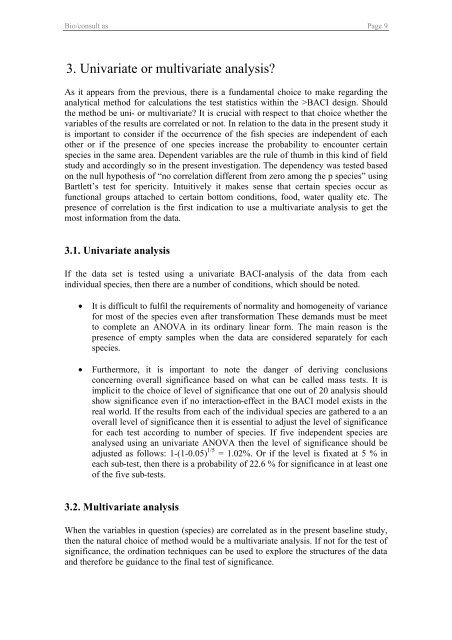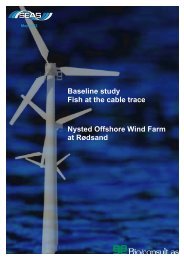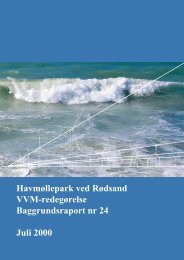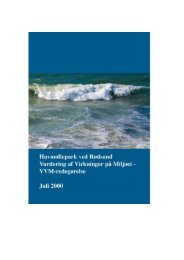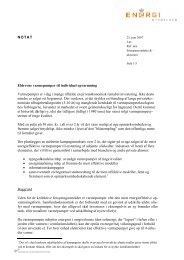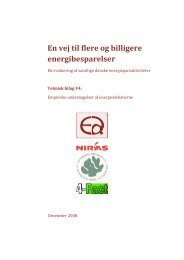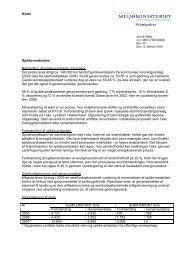Baseline study Fish, fry and commercial fishery Nysted Offshore ...
Baseline study Fish, fry and commercial fishery Nysted Offshore ...
Baseline study Fish, fry and commercial fishery Nysted Offshore ...
Create successful ePaper yourself
Turn your PDF publications into a flip-book with our unique Google optimized e-Paper software.
Bio/consult as Page 9<br />
3. Univariate or multivariate analysis?<br />
As it appears from the previous, there is a fundamental choice to make regarding the<br />
analytical method for calculations the test statistics within the >BACI design. Should<br />
the method be uni- or multivariate? It is crucial with respect to that choice whether the<br />
variables of the results are correlated or not. In relation to the data in the present <strong>study</strong> it<br />
is important to consider if the occurrence of the fish species are independent of each<br />
other or if the presence of one species increase the probability to encounter certain<br />
species in the same area. Dependent variables are the rule of thumb in this kind of field<br />
<strong>study</strong> <strong>and</strong> accordingly so in the present investigation. The dependency was tested based<br />
on the null hypothesis of “no correlation different from zero among the p species” using<br />
Bartlett’s test for spericity. Intuitively it makes sense that certain species occur as<br />
functional groups attached to certain bottom conditions, food, water quality etc. The<br />
presence of correlation is the first indication to use a multivariate analysis to get the<br />
most information from the data.<br />
3.1. Univariate analysis<br />
If the data set is tested using a univariate BACI-analysis of the data from each<br />
individual species, then there are a number of conditions, which should be noted.<br />
• It is difficult to fulfil the requirements of normality <strong>and</strong> homogeneity of variance<br />
for most of the species even after transformation These dem<strong>and</strong>s must be meet<br />
to complete an ANOVA in its ordinary linear form. The main reason is the<br />
presence of empty samples when the data are considered separately for each<br />
species.<br />
• Furthermore, it is important to note the danger of deriving conclusions<br />
concerning overall significance based on what can be called mass tests. It is<br />
implicit to the choice of level of significance that one out of 20 analysis should<br />
show significance even if no interaction-effect in the BACI model exists in the<br />
real world. If the results from each of the individual species are gathered to a an<br />
overall level of significance then it is essential to adjust the level of significance<br />
for each test according to number of species. If five independent species are<br />
analysed using an univariate ANOVA then the level of significance should be<br />
adjusted as follows: 1-(1-0.05) 1/5 = 1.02%. Or if the level is fixated at 5 % in<br />
each sub-test, then there is a probability of 22.6 % for significance in at least one<br />
of the five sub-tests.<br />
3.2. Multivariate analysis<br />
When the variables in question (species) are correlated as in the present baseline <strong>study</strong>,<br />
then the natural choice of method would be a multivariate analysis. If not for the test of<br />
significance, the ordination techniques can be used to explore the structures of the data<br />
<strong>and</strong> therefore be guidance to the final test of significance.


